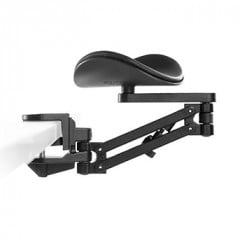Repetitive Strain Injury (RSI) is one of the most common issues we encounter in the workplace. According to the Chartered Society of Physiotherapy, around 450,000 workers in the UK suffer from upper limb RSI. Often caused by everyday tasks and poor working habits, RSI can significantly impact comfort, productivity, and long-term health. In this guide, we’ll explore what RSI is, the habits that can aggravate it, how to relieve RSI symptoms, and practical tips to help prevent RSI in the future.
What is RSI
RSI, or Repetitive Strain Injury, is a general term used to describe a range of painful conditions affecting the muscles, tendons, and nerves, usually in the upper body. It is also referred to as Upper Limb Disorder, instead of RSI. It can develop over time due to repetitive tasks, sustained awkward positions, or poor posture. It is often associated with activities such as typing, using a mouse, or manual handling. Commonly affected areas include the wrists, hands, forearms, elbows, neck, and shoulders. The symptoms of RSI can range from mild discomfort and tingling to severe pain, stiffness, or weakness, and they often worsen without early intervention. Although it’s commonly associated with desk work, RSI can affect people in a wide range of jobs.
RSI symptoms
Not to be confused with Carpal Tunnel Syndrome (CTS) caused by pressure on the median nerve in your wrist, RSI can present itself with a range of different symptoms. These often develop gradually and may worsen over time:
- Dull aches or pain
- Tingling and/or numbness
- Weakness
- Stiffness
- Cramp
- Throbbing
Identifying the cause of RSI
Seemingly minor actions, like repeatedly copying and pasting from a document, might not stand out as obvious causes of RSI. But over time, these small, repetitive movements can take a real toll. If you start to pay attention to how often you hover your mouse or move your arm throughout the week, you may be surprised by just how much strain builds up. Recognising these repetitive patterns is a crucial first step. By pinpointing the activities contributing to your RSI, you can put together a practical plan to reduce the strain and prevent the pain from becoming a long-term issue.
- Do you have a role that requires a lot of mouse work? Are you moving your mouse arm repetitively?
- Are you sitting correctly, or are you sitting too low down and reaching up to your keyboard?
- Have you adjusted your chair and your workstation? Make sure you know how to adjust your chair properly
- Can you attribute the problem to your workstation, or is there something contributing to it outside of work?

Are your input devices within the width of your shoulders?
For office workers, reducing the risk of RSI often starts with how your workstation is set up. One simple but effective adjustment is to ensure devices like your keyboard and mouse are positioned within shoulder width. This helps prevent overreaching, which can contribute to strain in the arms and shoulders over time. However, achieving this setup can be challenging without the right equipment. For example, if you rarely use the numeric keypad on a standard keyboard, consider switching to a compact keyboard. This allows you to keep your mouse and your arms closer to your body, promoting a more relaxed posture and reducing the risk of developing or aggravating RSI.
This kind of setup can be especially difficult for petite team members, who are often seated in chairs that are too large for their frame. When armrests are too far apart, smaller individuals tend to have to overreach. This can lead to raised shoulders and awkward postures, common contributors to RSI. To help reduce this strain, it’s important to adjust the armrests on your chair so they support your forearms comfortably, and sit as close to your body as possible. A well-fitted chair can make a significant difference in preventing RSI and promoting long-term comfort at work.
How do you use your mouse at work?
RSI is often made worse by overreaching for the mouse and performing the same tasks repeatedly throughout the day. To help ease symptoms and reduce strain, switching to an ergonomic mouse can make a big difference. Ergonomic mice are designed to keep your wrist in a more natural ‘handshake’ position, which helps minimise tension. For people who use a mouse constantly, such as designers working in the Adobe suite, we recommend a roller bar mouse. Positioned centrally in front of the keyboard, it reduces the need for wide arm movements. This helps to protect not just the wrist, but the entire arm and shoulder from repetitive motions that aggravate RSI.
With a Roller bar mouse, your palms rest on the padded section and you use the tips of your fingers to move the mouse, and depress the roller bar to click. One of the key benefits for those managing RSI is the ability to switch hands throughout the day. Because you can operate a Roller bar with either your left or right hand, it allows you to rest the side that’s experiencing RSI symptoms. This helps to reduce strain and encourage recovery, while still staying productive.
If a RollerMouse doesn’t suit your work, the UniMouse is another great option for managing and preventing RSI. It offers a familiar feel, similar to a traditional mouse, but is ergonomically designed to keep your wrist in a more natural, handshake-style position. This helps reduce tension in the wrist and forearm while still giving you the precision and control you’re used to. For many people, the UniMouse strikes a good balance between comfort and familiarity.
-
 Contour Balance keyboard£135.60 (incl VAT)
Contour Balance keyboard£135.60 (incl VAT) -
 Contour UniMouse Ergonomic Mouse£111.60 (incl VAT)
Contour UniMouse Ergonomic Mouse£111.60 (incl VAT) -
 Ergorest arm support£144.00 (incl VAT)
Ergorest arm support£144.00 (incl VAT)
Maintain an open employee/employer dialogue
As employers, we have several health and safety laws to abide by to make sure that we are taking care of our employees. If you are struggling with RSI, it’s better to deal with it sooner rather than later, and log it with your line manager or the person who takes care of DSE in-house.
If you need more advice on how to manage RSI, please leave us a message below and we will get back to you shortly. Alternatively you can give us a call on 0330 332 0880 or email enquiries@posturepeople.co.uk.







